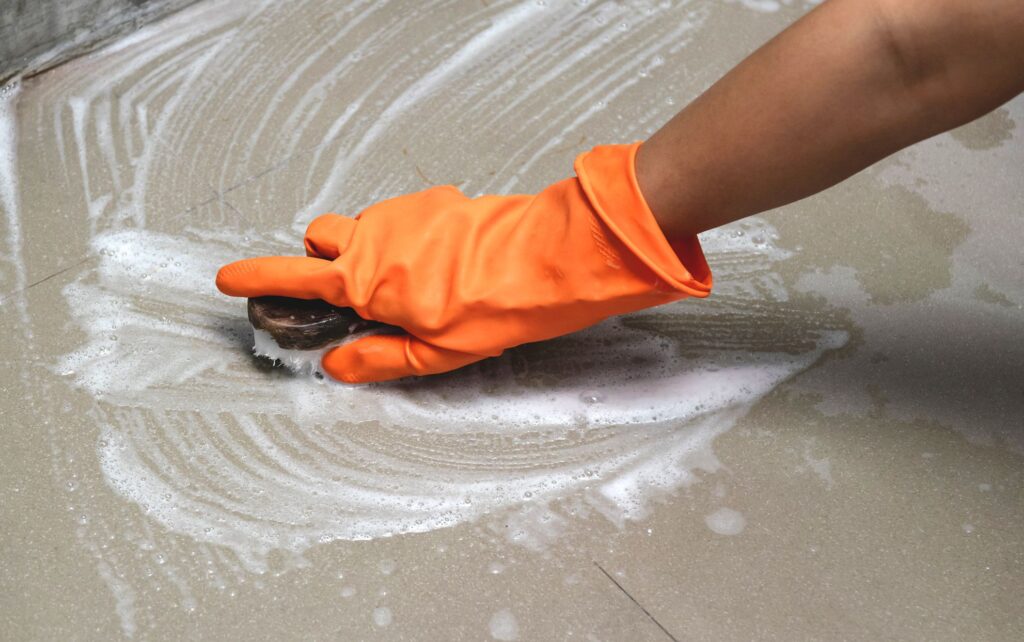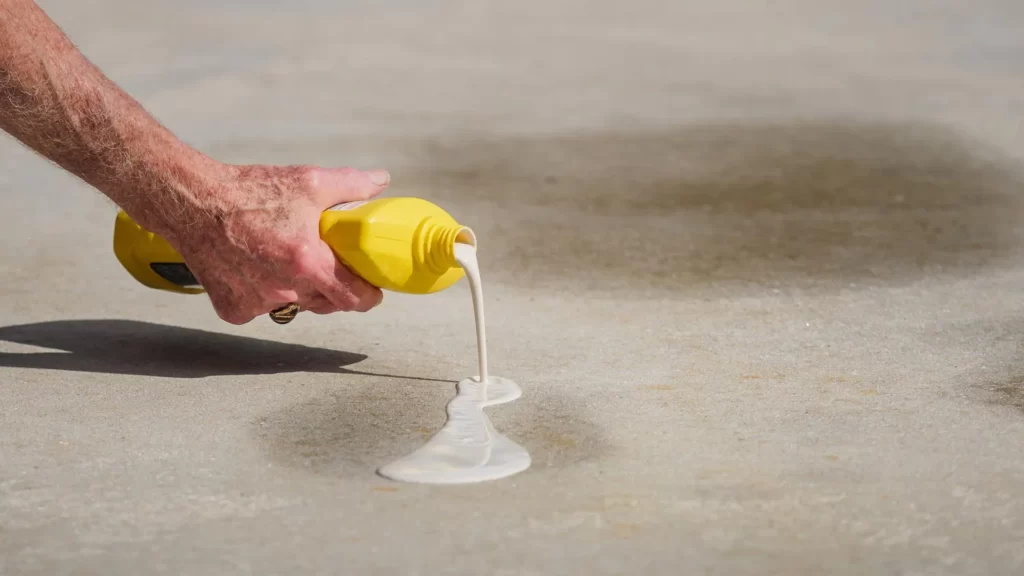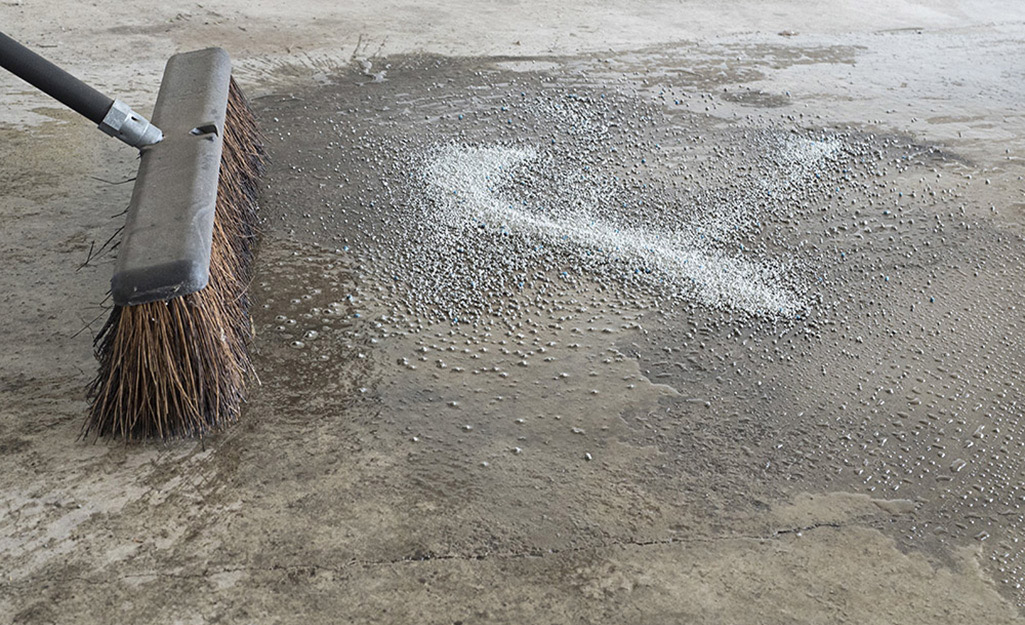Concrete surfaces, like your garage floors or driveways, are prone to oil stains, creating unsightly marks that can be tough to eliminate. These stains aren’t just a cosmetic issue; they can also degrade the quality of the concrete over time.
Understanding how these stains form can help you tackle them more effectively.
Basically, when oil spills onto concrete, it seeps into the porous surface, creating a stubborn stain that’s resistant to regular cleaning methods. Over time, these stains can become deeper and more ingrained, making them difficult to remove.
If you want to learn how to remove oil from concrete to restore the surface to its original appearance, we’re here to help.
Key Takeaways
- Fresh oil spills on concrete can be cleaned up by absorbing the oil with a substance like kitty litter, baking soda, or cornstarch.
- Persistent oil stains may require the use of a poultice made from an absorbent material and a strong solvent like acetone.
- Older stains can be managed with detergent-based removal methods, commercial concrete cleaners or degreasers, and microbial cleaners.
- DIY home remedies like vinegar, bleach, or Coca-Cola can damage the surface of the concrete and should be tested on a small, hidden area before large-scale use.
- Removing oil stains from a concrete driveway requires proper preparation and additional safety measures.
Absorbing Fresh Oil Stains and Oil Spills From Concrete Surfaces
When you’re faced with a fresh oil spill on your concrete, the first step is to absorb as much of it as possible before it can seep into the porous surface. Immediately grab an absorbent material like clay kitty litter, baking soda, or even cornstarch.
Generously sprinkle it over the spill, making sure the entire area is covered. Let it sit for several hours, allowing it to soak up as much oil as possible.
Once it’s done its job, carefully scoop up the now oil-soaked material and dispose of it properly.
Remember, time is of the essence, so act quickly and clean your concrete floors. This helps minimize the risk of the oil seeping deeper into your concrete and becoming a tougher stain to remove.
Removing Persistent Oil Stains on Concrete
If you’ve got stubborn oil marks on your concrete that refuse to budge even after a quick concrete cleaning, it’s time to employ a more aggressive cleaning approach.
Start by mixing a poultice using an absorbent material like kitty litter or sawdust and a strong solvent such as acetone.
Apply this mixture to the stain and let it do its magic. The solvent breaks down the oil stain while the absorbent material draws it up and out of the concrete.
If you don’t see results right away, don’t fret. Sometimes, you may need to repeat this process a few times to fully remove the stain.
Concrete Cleaners and Concrete Cleaning Techniques For Old Stain Removal
Despite your best efforts with the poultice technique, some old oil stains may stubbornly resist removal, so let’s explore additional methods specifically tailored for these tough, aged stains.
Detergent-Based Oil Removal

Take a look at these simple steps to rid your concrete of oil stains:
- Start by blotting up any excess oil with rags or paper towels.
- Next, sprinkle a layer of a good absorbent, such as cat litter or baking soda, over the stain.
- Let it sit for a few hours or overnight to absorb as much oil as possible.
- Finally, wash the area with a grease-cutting detergent and water, scrubbing with a stiff brush.
Commercial Cleaner and Degreaser Usage

If you’re looking to tackle stubborn oil spots and stains, you might want to consider picking up a commercial cleaner or degreaser. They’re formulated to break down oil and grease, making them an effective choice for this task.
Start by applying the cleaner according to the instructions on the bottle. Generally, you’ll want to cover the stain thoroughly, then let the cleaner sit for a while to penetrate the oil.
After that, use a stiff brush to scrub the area, enhancing the cleaner’s effectiveness. Rinse the area clean with a garden hose or pressure washer.
If the stain’s still visible, don’t be disheartened. It may take several applications and a bit of elbow grease to completely remove the stain.
Microorganism-Based Oil Clean-Up

If robust oil stains have tarnished your concrete and common household cleaners are proving futile, it might just be time to call in the microbes.
Consider using microbial cleaners like ACT Concrete Cleaner or Terminator HSD. These are special products that use microorganism-based cleaners to remove oil stains. Here’s how to do it:
- Pour these cleaners onto your oil stain. Make sure you cover the whole stain.
- Lightly spray the area with water. This signals the microbes to start their work.
- Let the microbes “eat” the oil stain, breaking it down into harmless substances. Over time, the stain will start to fade.
The process can take a bit of time. You won’t need to scrub or work hard, but you will need to wait. You may need to apply the cleaner a few times to fully get rid of the stain.
Just be patient. While this environmentally friendly oil clean-up strategy might require several applications and waiting periods, the results are generally worth it.
Microbial cleaners work efficiently on both concrete driveways and asphalt surfaces.
Cautionary Tips for Using DIY to Clean Oil Stains From Concrete Driveways
You might find suggestions online for using home items like vinegar, bleach, or Coca-Cola to clean oil stains from concrete. Some people think these items work well.
While they might get rid of the oil, they can also damage your concrete surface. They may leave a discolored spot where the oil used to be. This could spoil the look of your driveway, especially if it’s decorative concrete.
If you still want to try one of these products, be cautious. Try it first on a small, hidden area of your driveway or any concrete surface. This way, you can see what the result is without making a big change.
How to Effectively Remove Oil Stains From Concrete Driveways & Exterior Concrete
Whether it’s from a leaky car or an accidental spill, it’s important to know how to remove oil from your concrete driveway.
With the right techniques and a little bit of elbow grease, you can tackle those stubborn stains and restore the pristine appearance of your driveway.
Preparation and Safety Measures
Before you start tackling those stubborn oil stains on your driveway, it’s crucial that you’re well-prepared and mindful of important safety measures.
- Pick the right cleaning solution. Some are specifically designed for concrete driveways.
- Start from the highest point of your driveway to avoid dirty water flowing over cleaned areas. Be mindful of your plants and landscaping when using these cleaners.
- Remember, oil is flammable, so clean up spills promptly and safely.
- Don’t forget your safety gear. Gloves, protective clothing, and good ventilation are a must.
- Follow the manufacturer’s instructions for your cleaning products and dispose of contaminated materials properly.
Materials and Equipment Needed
Now that you’re aware of the necessary precautions, you’ll need several key items to effectively remove those pesky oil stains from your driveway. These include:
Cleaning Solutions:
- Cat litter: Absorbs oil, making it easier to remove.
- Baking soda: Works well for soaking up fresh oil stains.
- Dish soap: Cuts through grease and oil.
- Powdered laundry detergent: This can help lift stubborn stains.
- WD-40: Useful for dissolving and lifting oil.
Tools:
- Heavy-duty scrub brush or stiff nylon brush: Essential for scrubbing oil stains.
Methods:
Armed with your cleaning solutions and tools, you’re ready to tackle those stubborn driveway oil stains.
- Start by absorbing excess oil with cat litter.
- Next, mix baking soda and water into a paste, apply it to the stain, and scrub rigorously.
If that doesn’t work, try applyingdish soap directly to the oil stain and scrubbing with a heavy-duty brush. Powdered laundry detergent can also be effective.
- Sprinkle it over the stain, scrub with a stiff brush, then rinse with water.
- For really stubborn stains, apply WD-40, scrub, and rinse.
Patience is key here, as you might need to repeat the process to completely remove the stain.
Types of Oil Stains
You’ll encounter different types of oil stains on your driveway, each with its own unique characteristics. Knowing the type of stain can help you choose the best cleaning method.
Motor Oil: This common stain is from your vehicle’s engine. It’s dark and greasy.
- Removal tip: Absorb fresh spills with cat litter, then clean with dish soap.
Transmission Fluid: Often reddish, it’s slicker than motor oil.
- Removal tip: A degreaser usually works best.
Gasoline: A lighter oil, but it penetrates quickly.
- Removal tip: Use a commercial driveway cleaner for these stains.
Prevention and Environmental Impact of Oil Stains in Your Concrete Driveway
Oil spills can contaminate soil and groundwater, harm plants and animals, and even contribute to air pollution. To avoid these impacts, consider regular vehicle maintenance to prevent oil leaks.
Dispose of used oil properly, don’t just pour it out. Use drip pans or trays under your vehicles, especially when doing maintenance. If a spill happens, clean it up promptly.
Seal your driveway, this can help prevent oil from penetrating.
Conclusion
Whether it’s fresh spills or stubborn old marks, there’s a method for every situation. Remember, patience and persistence are key in this process.
If home remedies and commercial products fail, or you’re dealing with a particularly large or stubborn stain, don’t hesitate to call a professional concrete contractor.
Stone Protection experts have access to specialized treatments and equipment that can help return your concrete to its pristine state. Time can worsen certain types of stains, so don’t hesitate to get in touch with a concrete expert.
FAQ
What is the fastest way to get oil out of concrete?
The fastest way to get oil out of concrete is by using high-quality degreasers or dedicated oil stain removal products. It’s important to remember that concrete is porous, so a hard or dense finish will aid in preventing oil absorption.
How do you remove dried oil from concrete?
To remove dried oil stains from concrete, you can use a mixture of baking soda and water to make a paste. Apply this paste to the stain, let it sit, and then scrub it off.
Does Dawn dish soap remove oil from concrete?
Yes, Dawn dish soap can help remove oil from concrete. Mix the soap in warm water and use a brush to scrub the stain.
Does oil permanently stain concrete?
While oil can heavily stain your exterior concrete, it doesn’t necessarily permanently stain it. With proper cleaning using a quality degreaser or oil stain removal product, it’s possible to remove stains that persist.
Does WD 40 remove oil from concrete?
WD 40 is effective in cleaning oil from concrete. Spray the area, let it sit for a few minutes, and then rinse and clean concrete with a hose.
Can you power wash oil off concrete?
Power washing oil off concrete can be effective if the stains are not very old or deep. However, for deep oil stains, it’s advised to use a degreaser or baking soda paste first.
How do you remove old oil from a concrete driveway?
To remove old oil from a concrete driveway, it’s best to use a reliable degreaser following the product’s instructions, scrub the area well, and then rinse it off.
What works best to remove oil off the cement driveway?
The best way to remove old oil stains from the driveway is by cleaning and sealing. Start by applying a degreaser, scrubbing the area, and rinsing clean. Then consider sealing the concrete to resist future staining.
How do professionals remove oil stains from concrete?
Professionals often use commercial-grade degreasers and power washing equipment to remove oil stains from concrete. The cleaning process usually involves applying a degreaser, allowing it to soak, scrubbing the area, then rinsing it with a power wash. They may also apply a sealing product to prevent future staining.





